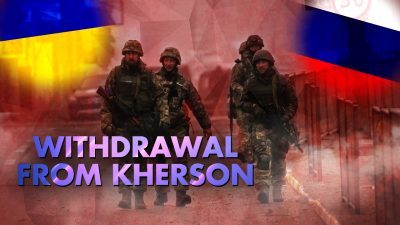Video: Russian Withdrawal from Kherson and Its First Political Results

All Global Research articles can be read in 51 languages by activating the Translate Website button below the author’s name.
To receive Global Research’s Daily Newsletter (selected articles), click here.
Follow us on Instagram and Twitter and subscribe to our Telegram Channel. Feel free to repost and share widely Global Research articles.
***
On November 9, the Russian military command officially announced its decision to withdraw the entire Russian grouping from the right bank of the Dnieper. The loss of control of Kherson has so far been Russia’s biggest military loss in the war in Ukraine.
According to various sources, on the morning of November 11, Ukrainian units approached the outskirts of the city of Kherson. In the western direction, they gained a foothold near Chernobayevka, where there was a warehouse of Russian equipment at the airfield. The personnel and the equipment were withdrawn from the village more than a week ago. To the north of the city, at night, Ukrainian forces approached the villages of Melovoe and Novokair.
On the morning of November 11, the Minister of Defense of Ukraine Reznikov announced that 40,000 Russian soldiers were allegedly cut off “in Kherson, around the city and on the western bank of the Dnieper River.”
His statements hardly responded to reality, since the entire Russian grouping in the Kherson region reportedly numbered about 50,000 soldiers and their withdrawal began much earlier. A few days before, several Russian units with all of their equipment left the right bank region.
Several units of the Russian special forces remained in the city until this morning to ensure the safety of the crossings. After these units withdrew to the left bank, the command was given to undermine the bridges. In the early morning, the Antonovsky Bridge, the bridge of the Kakhovskaya dam and other crossings were blown up.
Russian ferry crossings and groups of troops were covered by air defense units. The heavy artillery duels and strikes by the Russian Aerospace Forces aimed to slow down the Ukrainian advance as much as possible. In their turn, Ukrainian forces shelled the crossings all along the river. As a result of the shelling, one of the locks of the Kakhovskaya dam was damaged.
Together with the Russian troops, the evacuation of civilians continued as some people stayed in the city until the last despite the official evacuation which took place from October 18 until November 9. On November 11, the last ferry crossed the Dnieper to the left bank.
It seems that the surrender of the city of Kherson by the Russians has already brought political results. On November 11, the United States extended the license for all energy transactions with major Russian banks and the Central Bank for the third time since February. The US State Department said that Washington is waiting for signals of readiness for serious negotiations from Russia.
Turkish president Erdogan called Moscow’s decision to withdraw troops from Kherson correct and positive and announced his intention to hold talks with Putin.
*
Note to readers: Please click the share buttons above or below. Follow us on Instagram and Twitter and subscribe to our Telegram Channel. Feel free to repost and share widely Global Research articles.
SUPPORT SOUTHFRONT:
PayPal: [email protected], http://southfront.org/donate/ or via: https://www.patreon.com/southfront
Featured image is from SF

